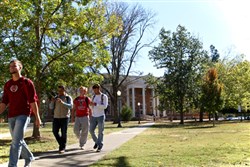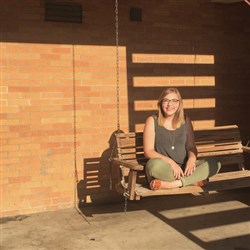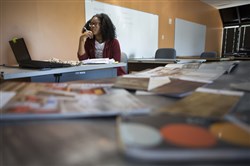VOL. 40 | NO. 44 | Friday, October 28, 2016
Small school tuition not what you think
By Linda Bryant

Maryville College, near Knoxville, is home to about 1,093 students with more than 97 percent receiving some kind of financial aid.
-- Adam Taylor Gash | The LedgerThis is the most important time of the year for college-bound high school seniors. Many are busy visiting college campuses, sweating over college entrance tests, juggling application deadlines and scavenging for scholarships.
One question many of them face is whether to attend a large public university or a small private school, and there are pros and cons to both choices, depending on an individual student’s personality, needs, interests and economic situation.
But one of the perceived disadvantages – the high cost of attending a small private school – is considered a myth by college administrators and professionals. Or, at the very least, an exaggeration.
Tackling sticker shock
In the 2015 National Association of College and University Business Officers (NACUBO) Tuition Discounting Study, private nonprofit colleges reported record-breaking tuition discount rates for 2015-16, besting last year’s results, which also set a record.
For the academic year 2015-16, the average institutional discount rate – or the percentage of total gross tuition and fee revenue institutions give back to students as grant-based financial aid – was an estimated 48.6 percent for first-time, full-time freshmen and 42.5 percent for all undergraduates.
In other words, these private colleges put about 42 cents on every dollar of tuition and fee revenue toward scholarships and grants.
“There’s definitely an impression that attending a small liberal arts college is the most expensive option for students,” says Cyndi Sweet, director of admissions of Maryville College, a 197-year-old school of about 1,093 about 18 miles from Knoxville.
“We aren’t free – and we might not be the least expensive – but what people don’t realize is that most of the time we are going to be competitive when it comes to affordability.
“In many cases, we have the opportunity to award more scholarships [than public universities],” Sweet adds. “And we offer other advantages. For example, our students have a chance to work directly with faculty every day in the classroom or lab.
“Professors know when a student isn’t in class. It’s not unusual for a professor to call, text or email a student and ask if everything is OK. It not unusual for a student to dog sit for a professor.”
For the 2016-17 school year tuition and room and board at Maryville College is $44,392. That’s a steep price tag, but more than 97 percent of students receive financial aid in the form of scholarships, grants, awards or need-based assistance.
Good tuition deals, stiff competition
The Council of Independent Colleges, an association of 765 nonprofit independent colleges and universities, finds students at smaller independent schools receive more than three times – $17,088 versus $5,476 – the amount of institutional aid compared to students at public institutions. And they receive more than five times – $17,088 versus $3,104 – as much as students at for-profit institutions.
Both categories of students pay less than 60 percent of the total cost of tuition.
Other trends reported by NACUBO show that over the past decade, tuition and fees at public institutions have increased twice as fast as at private colleges. And graduation rates at private colleges are higher than those at public and for-profit institutions, even for low-income students.
Students at private colleges graduate about ten months earlier than do their peers at public institutions and 48 months earlier than students at for-profit institutions – which means fewer years of paying tuition and a quicker start at earning a salary.
“If you don’t compete [with larger schools] you don’t exist for very long,” says Dan Boone, president of Trevecca Nazarene University in Nashville.
“Of course, you have to get out there and market your school. We try to effectively communicate what the Trevecca experience is like to [potential] students. That’s what smaller or lesser-known schools have to do.”
Trevecca, which is affiliated with the Church of the Nazarene denomination, has benefitted from vigorous marketing to prospective students via social media, direct marketing, church buying, name and list buying and event sponsorship.
One event, Camp Electric, is a Christian rock music camp that attracts hundreds of attendees, all of whom get a feel for Trevecca during their visits.
This academic year the 115-year-old school’s undergraduate enrollment reached an all-time high for the third consecutive year. Enrollment for the 2016-17 year is 1,374. Members of the freshman class hail from 36 states and 22 countries.
A strong retention rate, increased applications and significant numbers of transfer students all contributed to the enrollment spike,” Boone says.
Tuition and room and board at Trevecca this year is $33,216, and the majority of students have scholarships and/or financial aid.
What students say
Jordan McCullough, who grew up on a farm in Wilson County about 30 miles from Nashville, says he knew three things when he began his college search: He wanted to go to a small school with a collaborative environment, he wanted to play football and he wanted to broaden his world beyond Middle Tennessee.

McCullough
McCullough considered several schools, including Maryville College, Sewanee: The University of the South, Rhodes College in Memphis and Denison University in Denison, Ohio.
He chose Maryville College decisively – and with a passion.
“I knew I wanted to go to Maryville College from the very first time I was on campus,” McCullough says. “Nothing against the other great schools, but I immediately felt cared about here.”
A designated “student ambassador,” McCullough loves to promote his college and dish general advice to students searching for the right school.
“I tell people [students looking for a good school match] to put aside all the statistics about a school,” McCullough points out.
“I tell them to go by the way the school makes them feel. Don’t choose a school because it looks good on paper or because it has pretty buildings. Think about whether you are going to have a good experience or not.”
McCullough did play football his first two years of school, but he eventually became interested in so many different academic and extracurricular topics that he was forced to push football to the side.
One of his high-profile campus roles is president of Voices of Praise, a choir fashioned in the black gospel tradition. It’s not unusual for him to croon a solo or go on a mini-tour with the choir.
“I’m not sure there’s another place where a white boy from Middle Tennessee with blonde hair and a red beard could be president of a black choir,” McCullough notes.
“Maryville is a college for fighters,” he adds. “We’re a free-thinking utopia here in the middle of the mountains. The school’s emphasis on critical inquiry and diversity is a perfect fit for me.”
Sweet echoes McCullough’s description of Maryville as a highly diverse educational setting and explains that the school’s diversity is a key selling point for the school.
“We’re affiliated with the Presbyterian Church, and yet many different faiths and cultures are represented on campus,” she says. “We have open dialogues [about diversity and faith.]
“We look for students who have academic and leadership potential.” Sweet adds. “Maybe it’s a student who didn’t peak in high school and who’s looking for a place to build on their skills and abilities. So many students grow and mature during their four years here, and they really are a different person when they leave.”
Maryville recently admitted its first transgender student. Campus activities range from College Democrats to College Republicans to the Gay-Straight Alliance to the Latino Student Alliance.
Molly Vinson, a senior marketing major at Trevecca, says she decided to attend the school because she was looking for a place she could bloom as a self-described “introvert.”

Vinson
-- Michelle Morrow | The Ledger“I didn’t want to have to fight for my survival,” Vinson says.
Vinson knew she wanted to go to a Christian-identified school but didn’t have a feel for how to distinguish between her choices. She looked at 10 schools, including Belmont and Lipscomb universities, and considered Trevecca her “safety school” until her on-campus visit.
“I loved so many things about this school,” Vinson says. “I loved the location and the fact that Trevecca is an urban ministry that serves in the very neighborhood it’s located in. The academic rigor is real. You have to study; it’s not just a breeze here. But I also I felt like I’d be noticed at Trevecca.”
Before she committed to the school, Vinson says a Trevecca math professor reached out to her via email to check up on her. The communique made a difference.
“I could tell she really cared and wanted me to be here,” Vinson adds.
Trevecca is located on a bucolic campus in South Nashville close to a couple of Nashville’s poorest neighborhoods. Students work directly among neighbors with everything from tutoring to reclaiming polluted land to gardening side by side.
Boone calls Trevecca’s emphasis on social justice and sustainability “Christianity that reaches out to the community.”
Uber-small specialty schools
Maryville College and Trevecca Nazarene University are small schools with over 1,000 undergraduates and a wide-ranging choice of majors. But some students are a better fit with even smaller schools with a highly focused – but more limited – choice of majors and subjects.
Enter Watkins College of Art, Design & Film, a tiny fine arts college in Nashville with an undergraduate enrollment of about 250 students.
“To make sure a student is a good fit with a school like Watkins, we try to be sure the student knows that he or she is an artist when they cross that threshold to our school,” says Watkins President Jay Kline.
“Our ideal student needs to have already developed foundation skills [in art]. We look at their portfolio and essay and make sure they are academically capable.
“To succeed here takes a certain kind of student who’s going to thrive in a community of artists,” Kline adds. “Thirty percent of our classes are liberal arts, but it’s also important that students see life through the lens of an artist.”
Watkins majors include art, photography, interior design, film and fine art. Tuition and room and board is $30,200, and Kline says the “overwhelming majority” of students receive financial aid and/or scholarships.
Casey McDonald, an 18-year-old photography major, is one such student.

Interior Design student Renee Johnson (sophomore) listens to her instructor during a lecture at Watkins College of Art, Design & Film.
-- Michelle Morrow | The LedgerMcDonald attended an arts magnet school in South Florida that required him to declare a major at the high school level. When he graduated from high school he boiled his college search down to two schools – the School of Visual Arts (SVA) in New York City and Watkins.
Although SVA is at the center of the New York art scene, McDonald choose Watkins for three main reasons: he thought he’d get more attention from his professors at Watkins, he loved Nashville and tuition and fees at SVA were radically higher than Watkins.
“SVA was 55K a year or more and that didn’t even count living in New York City,” McDonald says. “If I’d gone to SVA I wouldn’t even have been able to take classes in my major my first year.
“I’m able to do that at Watkins. Plus, my professors take an interest in me. My classes are challenging; they’re not easy. If I need to stay after class to ask questions of my professor, it’s no problem.
“My art feels relevant here,” he adds.
Watkins is a part of the Association of Independent Colleges of Art and Design, a 42-member cohort of schools that include well-known national art schools such as the Rhode Island School of Design, The Art Institute of Chicago and Parsons.
Among the entire cohort of schools Watkins is the second least expensive, Kline says.
Because the school is in “good financial shape” and garnering more and more interest from students and potential employers of those students, Watkins is going through a rebranding process meant to expose it to a wider national audience.
“We’re getting very serious about building another dorm and laying the groundwork for semester-long exchanges with other (overseas) schools,” Kline says. “Our biggest challenge is creating a bigger endowment fund. We want to give opportunities to more and more people.”